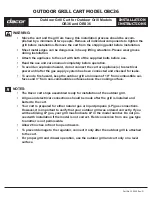
19
and could seriously damage the barbecue.
In the event of a fat fire:
If safe to do so, turn all control knobs to the
‘off’ position.
Turn off the gas supply at the gas bottle.
Keep everyone at a safe distance from the
barbecue and wait until the fire has burnt
out.
Do not close the hood or lid of the barbecue.
NEVER DOUSE A BARBECUE WITH
WATER. IF AN EXTINGUISHER IS USED,
IT SHOULD BE A POWDER TYPE.
DO NOT REMOVE THE DRIP TRAY .
If the fire does not seem to be abating or
appears to be worsening, contact your local
Fire Brigade for assistance.
End of Cooking Session
After each cooking session, turn the barbecue
burners to the “high” position and burn for 5
minutes. This procedure will burn off cooking
residue, thus making cleaning easier. Make
sure the hood
or lid is open during this process.
Turning Off Your Barbecue
When you have finished using your barbecue,
turn all the control valves fully clockwise to the
“Off” position, then switch off the gas supply at
the bottle.
Wait until the barbecue is sufficiently cool
before closing its hood.
Care and Maintenance
Regularly clean your barbecue between uses
and especially after extended periods of
storage. Ensure the barbecue and its
components are sufficiently cool before
cleaning. Do not leave the barbecue exposed to
outside weather conditions or stored in damp,
moist areas.
Never handle hot parts with unprotected
hands.
Never douse the barbecue with water when
its surfaces are hot.
In order to extend the life and maintain the
condition of your barbecue, we strongly
recommend that the unit be covered when left
outside for any length of time, especially during
the winter months. Heavy-duty barbecue covers
and other accessories are available from your
local stockist.
Even when your barbecue is covered for its
protection, it must be inspected on a regular
basis as damp or condensation can form which
may result in damage to the barbecue. It may
be necessary to dry the barbecue and the
inside of the cover. It is possible for mould to
grow on any fat remaining on parts of the
barbecue. This should be cleaned off smooth
surfaces with hot soapy water.
Any rust that is found that does not come into
contact with the food should be treated with a
rust inhibitor and painted with barbecue paint or
a heat resistant paint.
Cooking Surfaces & Warming Rack
When the barbecue has cooled, clean with hot
soapy water. To remove any food residue, use
a mild cream cleaner on a non-abrasive pad.
Do not use scouring pads or powders as they
can permanently damage the finish. Rinse well
and dry thoroughly. Due to the weight of the
cooking surfaces, we do not recommend
cleaning in a dishwasher.
Burner
Provided that they are operating correctly, in
normal usage, burning off the residue after
cooking will keep the burners clean.
The burners should be removed and cleaned
annually, or whenever heavy build-up is found,
to ensure that there are no signs of blockage
(debris, insects) in either the burner portholes or
the primary air inlet of the burners. Use a pipe
cleaner to clear obstructions.
When refitting the burners, be careful to check
that the neck of the burner fits over the valve
outlet.
It is quite normal for surface rust to be present
on the burners. If rust appears between uses or
in storage, clean with a soft brass wire brush.
Flame Tamer
Remove any food residue from the flame tamer
surface with a plastic or wooden scraper or
brass wire brush. Do not use a steel scraper or
wire brush. Clean with hot soapy water and
rinse well.
Drip Tray
After every use, empty and clean the drip tray
(and foil liner, if applicable) of any fat or food
particles, using a plastic or wooden scraper if
necessary.





































